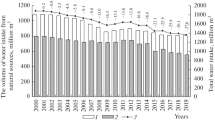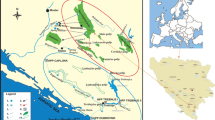Abstract
This paper summarizes the problems and consequences associated with water use in the Russian and Chinese parts of the Amur river basin. Taking into consideration the set of indicators involving the water withdrawal, the utilization of source water, the volumes of recirculated and repeated-consecutive water supply, the volumes of waste waters, the capacity of pollution control facilities, etc., an outline is given of the present status of water use in the national parts of the basin. The future amounts of water consumption are forecasted, and it is shown how it will increase in the Russian as well as the Chinese parts. An analysis of the spatiotemporal dynamics of water-use indicators revealed the differently directed tendencies in the water-use pattern in the Russian and Chinese parts of the Amur river basin, and the existence of quantitative disproportions caused by a different degree of development and a different intensity of economic growth. In the Russian part of the basin, the amounts of water used have stabilized in recent years after a decrease, whereas they are increasing steadily in the Chinese and Russian parts where the highest proportion of water is used to meet agricultural and production needs, respectively. It is shown that water use, the density of the water-economy structure and the discharges of pollutants in the Chinese part of the basin are larger by factors of several tens than those in the Russian part. The manufacture of water-intensive industrial products and the load of agriculture on water resources also differ by factors of several tens. The indicator of population size is used to characterize the degree of development of the basin’s territory. For the Russian part of the basin the study revealed a dependence of water consumption on the population size and on the volumes of water-intensive products in the production facilities with a low coefficient of recirculated water use. This dependence can also be extended to the Chinese part where circulated water supplies are being used only moderately.
Similar content being viewed by others
References
The Water-Ecological problems of the Amur River Basin, A.N. Makhinov, Ed., Vladivostok: Izd-vo DVO RAN, 2003 [in Russian].
Makhinov, A.N., The Ecological Problems of Transboundary Impacts Within the Amur Basin, Geografiya i Ekologiya v Shkole XXI Veka, 2007, no. 8, pp. 10–15 [in Russian].
Makhinov, A.N., Transboundary Ecological Problems in the Middle and Lower Reaches of the Amur River, Proc. Sci. Conf. Social, Ecological and Economic Problems of Development of the Russia-China-Mongolia Border Regions (October 20–22, 2010, Chita), Chita, 2010, pp. 67–72.[in Russian].
Govorushko, S.M. and Gorbatenko, L.V., Transboundary Water Management in the Amur River Basin, Vestn. DVO RAN, 2013, no. 2, pp. 74–83 [in Russian].
B aklanov, P.Ya. and Voronov, B.A., Global and Regional Risks of Sustainable Development in the Amur Region, Izv. RAN, Seria Geogr., 2010, no. 2, pp. 17–24 [in Russian].
Demin, A.P., Present-Day Problems of Water Supply to the Agricultural Farming in Russia, Prirodoobustroistvo, 2008, no. 2, pp. 37–44 [in Russian].
Shiklomanov, I.A., Georgievskii, V.Yu., Babkin, V.I., and Balonishnikova, Zh. A., Research Problems of Formation and Estimation of Water Resources and Water Availability Changes of the Russian Federation, Russ. Meteorol. Hydrol., 2010, vol. 35, issue 1, pp. 13–19.
Shiklomanov, I.A., Babkin, V.I. and Balonishnikova, Zh. A., Water Resources, Their Use, and Water Availability in Russia: Current Estimates and Forecasts, Water Resour., 2011, vol. 38, issue 2, pp. 139–148.
Elaboration of the SKIOVO Project of the Amur River Basin. Book7. Summary Volume SKIOVO Amur River. Stage 6. Report of FGUP RosNIIVKh. URL: http:// wwwamurbvuru/deyatelnost/skiovo/576-skiovo-pobasseynu- reki-amurhtml (Accessed 03.24.2014) ]in Russian].
Ganzei, S.S., Yermoshin, V.V., Mishina, N.V., and Shiraiwa, T., Current Land Use in the Amur Basin, Geogr. Prir. Resur., 2007, no.2, pp. 17–25 [in Russian].
The Russian Far East: Economic Potential, P.A. Minakir and N.N. Mikheeva, Vladivostok: Dal’nauka, 1999} [in Russian]
Rosstat Website.URL: http://wwwgksru/ (Accessed 12.18.12.2014) [in Russian].
The National Economy of the RSFSR in 1979: Statistical Yearbook, Moscow: Statistika, 1980} [in Russian]
Russian Statistical Yearbook. 1994. Statistical Digest, Moscow: Goskomstat Rossii, 1995 [in Russian].
Regions of Russia: Statistical Digest, in 2 Vols, Moscow: Goskomstat Rossii, 2001, Vol. 2 [in Russian].
Russian Statistical Yearbook. 2008. Statistical Digest 2008, Moscow: Statistika Rossii, 2009 [in Russian].
Regions of Russia. Socioeconomic Indicators. 2009. Statistical Digest, Moscow: Statistika Rossii, 2010} [in Russian]
Program “Socioeconomic Development of the Far East and Baikal Region”. URL: http://basegarantru/ (Accessed 05.15.2014) [in Russian].
Integrated Water Consumption and Water isposal Rates for Different Branches of Industry, 2nd Rev. Edit., Moscow: Stroiizdat, 1982 [in Russian].
Heilongjiang Statistical Yearbook, L. Shusheng, Ed., Beijing: China Statistics Press, 2010.
Inner Mongolia Statistical Yearbook, H. Minqian, Ed., Beijing: China Statistics Press, 2010.
Jilin Statistical Yearbook, C. Chan, Ed., Beijing: China Statistics Press, 2010.
Website of the National Bureau of Statistics of the PRC. URL: http://wwwstatsgovcn/ (Accessed 01.15.2015).
Gao, Jay, and Liu, Yansui, Climate Warming and Land Use Change in Heilongjiang Province, Northeast China, Appl. Geogr., 2011, vol. 31, issue 2, pp. 476–482.
China Statistical Yearbook on Environment, M. Jingkui and L. Bingjiang. Eds., Beijing: China Statistics Press, 2011.
Mao, Zhi, Water Efficient Irrigation and Environmentally Sustainable Irrigated Rice Production in China. Paper for ICID Annual Meeting. International Commission on Irrigation and Drainage. 2000. URL: http://wwwicid. org/wat_maopdf (Accessed 03.07.2012).
Karakin, V.P. and Sheingauz, A.S., Land Resources of the Amur River basin, Vestn. DVO RAN, 2004, no. 4, pp. 23–38 [in Russian].
Ganzei, S.S., Geoecological Research on Transboundary Territories of the South of the Russian Far East, Vestn. DVO RAN, 2004, no. 6, pp. 82–91 [in Russian].
Ganzei, S.S., Transboundary Gradients of the South of the Russian Far East and Heilongjiang Province, Regional’naya Ekologiya, 2005, nos. 3–4, pp. 74–80 [in Russian].
Author information
Authors and Affiliations
Corresponding author
Additional information
Original Russian Text © L.V. Gorbatenko, 2016, published in Geografiya i Prirodnye Resursy, 2016, Vol. 37, No. 2, pp. 27-35.
Rights and permissions
About this article
Cite this article
Gorbatenko, L.V. Water use in the transboundary basin of the Amur river. Geogr. Nat. Resour. 37, 114–122 (2016). https://doi.org/10.1134/S1875372816020049
Received:
Published:
Issue Date:
DOI: https://doi.org/10.1134/S1875372816020049




